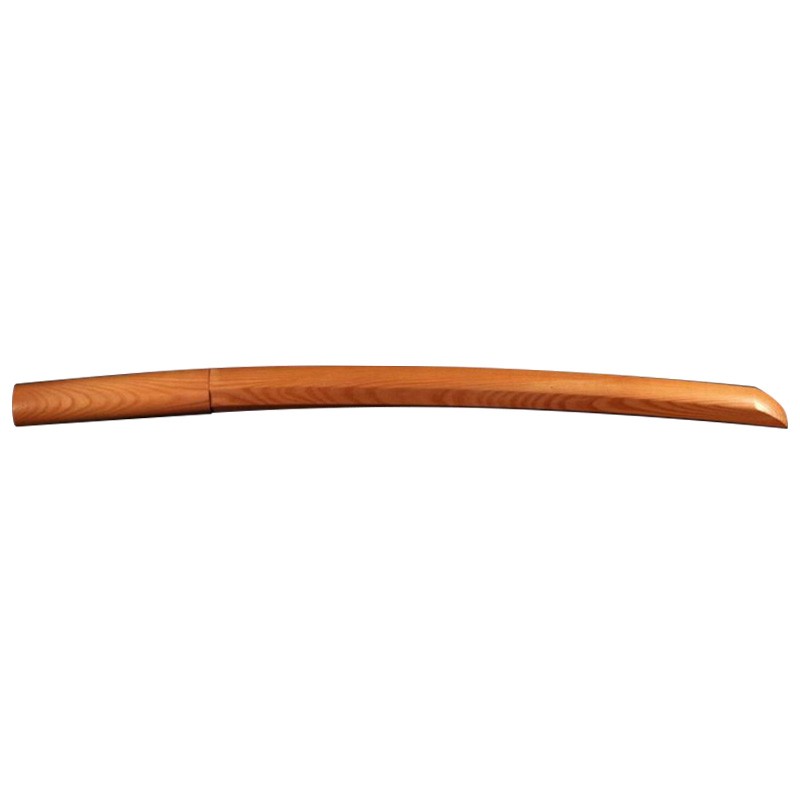

More informations about this product
The Classic-shaped Wakizashi 脇 差, is the short sword held in one hand. It appeared around the Muromachi period, period of wars. Its maneuverability, by its size, made it an ideal weapon with hand to hand. It is today very little used. We find his practice in the Niten (with two swords), in Kendo, or in traditional schools (Koryu).
The whole product is made in one piece of wood by Aramaki workshops, and above all, not varnished.
This Wakizashi in Biwa 枇 杷– Loquat (Loquat) is suitable for advanced and experienced practitioners.
This wood has a medium density to a tight fiber in shades of pink.
It is a very beautiful essence, dense and pleasant in hands. However, it remains little recommended for martial practice, which can mark on slightly intense shocks.
Avoid for strong, sustained and repeated contacts.
Its shape takes the characteristics of a Japanese short sword, with a demarcated handle (Tsuka), a pronounced curvature (Sori), a rounded tip (Aikido Gata), the transverse line (Shinogi) on the sides of the blade part, the line perpendicular to the edge (Yokote) delimiting the point and back of the blade part (Mune) is flat (Hira Mune).
Features:
(nb: the production being artisanal, the measurements, especially the weight, can be subject to very slight variations.)
Wood: Upper Medlar, Hon Biwa 枇 杷 - ほ ん ビ ワ
Origin: Kirishima Sankei Forest, Kagoshima Prefecture, South Kyushu.
Botanical Name: Eriobotrya japonica
Tree growth time before felling for preparation and drying: 150 to 300 years
Hue: Rosé / Fibre: Dense and tight / Weight: Medium/ Resistance: Good but easily scores
Aramaki Workshop: “Aramaki Budogu Mokojo” 荒 牧 武 道 具 木 工 所
Miyakonojo, Miyazaki-Ken, Kyushu, Japan (Southwest).
Founded by the Aramaki family around 1920.
Currently led by the 3rd generation Aramaki, Aramaki Yasuo, Artisan Name Kazuhiro.
Recognitions, Titles: «Ō-ju Hōshō»* awarded by the Emperor of Japan.
(«Ō-ju Hōshō» (黄 綬 褒 章): «Yellow Ribbon Medal», this distinction is awarded to “those who by their diligence in their affairs became models for the people”. Created in 1887, it was immediately repealed and only restored in 1955.)
Message from Masamune team: The productions of the Aramaki workshop are incomparable, it is considered the excellence of the workshops formalized by the Japanese government. To know that to date there are only 3 official Japanese workshops and that the Aramaki workshop is the only one to be able to produce enough for export outside Japan.
This workshop has kept a traditional manufacturing method, especially for the selection of species and pieces of wood, but also thanks to a natural drying that preserves the fibers and qualities of the wood. This traditional process makes it possible to obtain resistant, robust, pleasant and durable training weapons. The finish of the Aramaki workshop is also remarkable because after the shaping of the weapons using different types of planes successive craftsmen finish the surfacing with very fine sandpaper, giving a feeling of velvet texture.
Masamune Team Conversation Tips:
Wooden weapons are ideal training products, however care must be taken, know how to keep and maintain them for optimal safety and preservation. Wood, although «dead», remains a reactive material to changes in temperature and especially humidity.
- Keep the weapons horizontal, which helps maintain a stable and homogeneous moisture content throughout the wood.
- Store in a room that 'breathes', avoid cellars, attics, car chests.
- Do not leave near a heat source, avoid leaving close to a radiator, underfloor heating, or too regular sun exposure.
- Do not leave near a source of moisture, avoid leaving near entrance doors or windows.
Over time and especially practice, wood fibers can be subject to alterations, in order to prevent or maintain at least the degradations, you can:
- Apply on the surface with a cloth additives such as beeswax or oils (flax for example)
- Soak in oil for about 2-4 weeks, then dry for 2-4 months. This process remains quite long and tedious, it adds weight to the weapon and can vary the balance.
- In case of surface alteration, broken fiber, splinters, sand to sandpaper. Depending on the damage, you will sometimes have to remove a lot of material, then take different grains of paper, from the coarser (50 to 100) to the finer (600 and more).
Finally, for your safety, that of your partners and the people around you, never practice with a weapon that is split or even too fragile. This can cause splinters, splinters and parts to fly away on contact with another weapon, and injure people around.
Share your opinion
error Your review appreciation cannot be sent
feedback Report comment
check_circle Report sent
error Your report cannot be sent